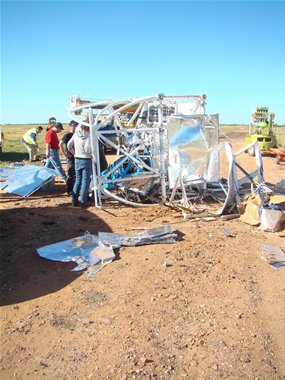NASA Science Balloon Crashes
What was suppose to be a regular day of balloon-launching in the Australian outback turned into balloon-dodging. A NASA balloon equipped with two telescopes to survey the sky at an altitude of 36,576 meters crashed on lift-off–a gust of wind sent the balloon sailing horizontally, it wiped through a fence and overturned a sports utility vehicle before smashing into the ground. The balloon narrowly missed nearby spectators.

Broadcasting Corporation
It’s unclear how much damage the onboard science instruments sustained but by the looks of the video (below) of the incident, taken by the Australian Broadcasting Corporation (ABC), it can’t be good. The balloon was carrying a gammy-ray telescope built by astronomers at the University of California, Berkeley, called the Nuclear Compton Telescope meant to study astrophysical sources in space.
According to ABC news, the crash was “gut-wrenching” for researchers watching, who have spent many years and ample resources on the multi-million dollar balloon. It was built by NASA’s Columbia Scientific Balloon Facility in Palestine, Texas.
The researchers have been picking up the pieces and will conduct a full investigation of the accident. Meanwhile the Balloon Launching Center in Alice Springs will prepare for another balloon launch in May.
Keep Reading
Most Popular
Large language models can do jaw-dropping things. But nobody knows exactly why.
And that's a problem. Figuring it out is one of the biggest scientific puzzles of our time and a crucial step towards controlling more powerful future models.
How scientists traced a mysterious covid case back to six toilets
When wastewater surveillance turns into a hunt for a single infected individual, the ethics get tricky.
The problem with plug-in hybrids? Their drivers.
Plug-in hybrids are often sold as a transition to EVs, but new data from Europe shows we’re still underestimating the emissions they produce.
Stay connected
Get the latest updates from
MIT Technology Review
Discover special offers, top stories, upcoming events, and more.